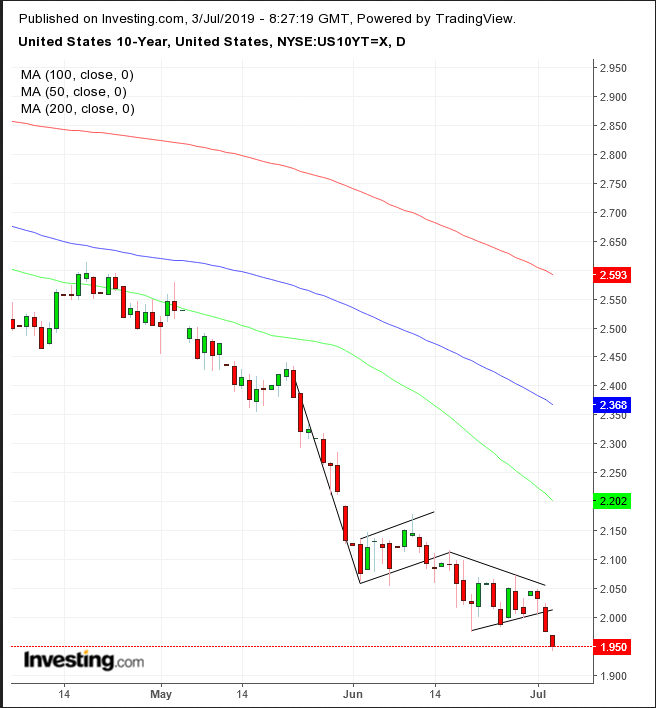- Treasury yields hit lowest level in two and a half years on increased outlook for dovish Fed, ECB
- U.S. futures, European shares also rise, magnifying market anomaly
- Oil rebounds from muted reaction to OPEC+ supply cuts extension
- U.S. markets remain closed on Thursday in observance of the Independence Day.
- The U.S. jobs report, due on Friday, is projected to show nonfarm payrolls rose by 160,000 in June, rebounding from 75,000 the previous month.
- The U.K.’s FTSE 100 climbed 0.4% to the highest in about 10 months.
- The MSCI Emerging Market Index dropped 0.6%, the biggest drop in more than a week.
- The MSCI Asia Pacific Index slid 0.4%, the largest decrease in more than a week.
- The Dollar Index gained less than 0.05%.
- The euro fell 0.1% to $1.1269, the weakest in two weeks.
- The British pound slipped 0.3% to $1.2559, the weakest in more than two weeks.
- The Japanese yen rose 0.2% to 107.67 per dollar, the strongest in more than a week.
- The yield on 10-year Treasurys declined three basis points to 1.95%, the lowest in more than two years.
- Germany’s 10-year yield fell three basis points to -0.40%, hitting the lowest on record with its fifth straight decline.
- Britain’s 10-year yield slid two basis points to 0.699%, the lowest in almost three years.
- West Texas Intermediate crude gained 0.3% to $56.42 a barrel.
- Gold gained 0.4% to $1,424.30 an ounce, the highest in more than six years.
Key Events
The yield on the 10-year Treasury hit its lowest level since Nov. 8, 2016 this morning as global bonds enjoyed a powerful rally on the expectation of dovish monetary policy from the world's two pivotal central banks. Christine Lagarde, currently at the helm of the International Monetary Fund, was nominated as the next president of the European Central Bank, with analysts pointing out her lead will most likely mark a continuation of Mario Draghi's accommodative stance.
Europe's STOXX 600 climbed for the fourth consecutive day, reaching an 11-month high on hopes Lagarde, who in the past praised negative interest rates as a "net positive" for the global economy, will contribute to a low-rate business environment.

Futures on the Dow, the NASDAQ 100 and the S&P 500 also flashed green, with the last of the three in particular benefiting from the fact the SPX closed at a new record price on Tuesday, helped by U.S. President Donald Trump's plans to pick Christopher Waller and Judy Shelton for the Federal Reserve Board—both candidates seen as likely to advocate lower interest rates. Technically, both the RSI and the MACD are oversold, leaving the onus on the bulls to show how confident they are in the current rally.
In the early Asian session, regional indices edged lower as optimism spurred by the U.S.-China tariff truce waned after White House trade adviser Peter Navarro reiterated a final trade deal "will take time."
South Korea’s KOSPI (-1.23%) underperformed its peers for the third straight day, penalized by Japan's move to restrict tech-materials exports to its neighbor.
Australia’s S&P/ASX 200 (+0.49%) bucked the trend, helped by climbing consumer and commodity shares. Financial equities, conversely, muted the rally, pressured by the outlook for tighter lending regulations.
Global Financial Affairs

Technically, Treasury yields extended a downside breakout to a bearish pennant, following a bearish flag, suggesting lower levels.
The divergence currently observable between multi-year lows for yields and record highs for equities represents an anomaly. Traditionally, an outlook for economic growth would boost stocks at the expense of bonds, sending yields higher. On the other hand, if the economy was seen slowing down, investors would sell stocks—expecting companies to lose profits in a contracting economy—in favor of bonds—pushing yields lower.
At present, however, investors are buying stocks on expectations of higher company profits and purchasing bonds on forecasts of falling interest rates—which in turn would be policymakers' response to a softer economy.
There are several factors that help explain this contradiction, the main one being the fact that the current post-QE market has grown dependent on policy accommodation. We have recently pointed out that solid economic data mysteriously caused equity selloffs, while weak economic numbers at times boosted stocks. Even Monday’s late-session losses, prompted by evidence of the world's slowing manufacturing activity, were very quickly reversed, as investors pushed shares back to record highs on Tuesday.
If and when the economy enters an obvious recession, central bank stimulus would no longer be enough to support disproportionate equity prices. Perhaps, then the market would recalibrate, and bonds and stocks would return to possess a negative correlation.
Meanwhile, we are keeping a weathered eye open for the breaking point: when will investors start to react to the anomaly of ever-bullish stock prices against the backdrop of a deepening yield curve inversion? And will that lead to panic selling in the stock market, in favor of bonds—which would ironically push yields even lower?

In the commodities space, WTI rebounded from a flat reaction to confirmation from OPEC+ oil producers that they will extend supply cuts for another nine months. The lack of an OPEC-driven rally prompted some analysts to point out how the cartel's output quotas are far from being the main driver of the oil market supply dynamics. In the early session, the price blew out a bullish flag and fell back below the 200 DMA, reinforcing the downtrend line since April 23.
Up Ahead
Market Moves
Stocks
Currencies
Bonds
Commodities
